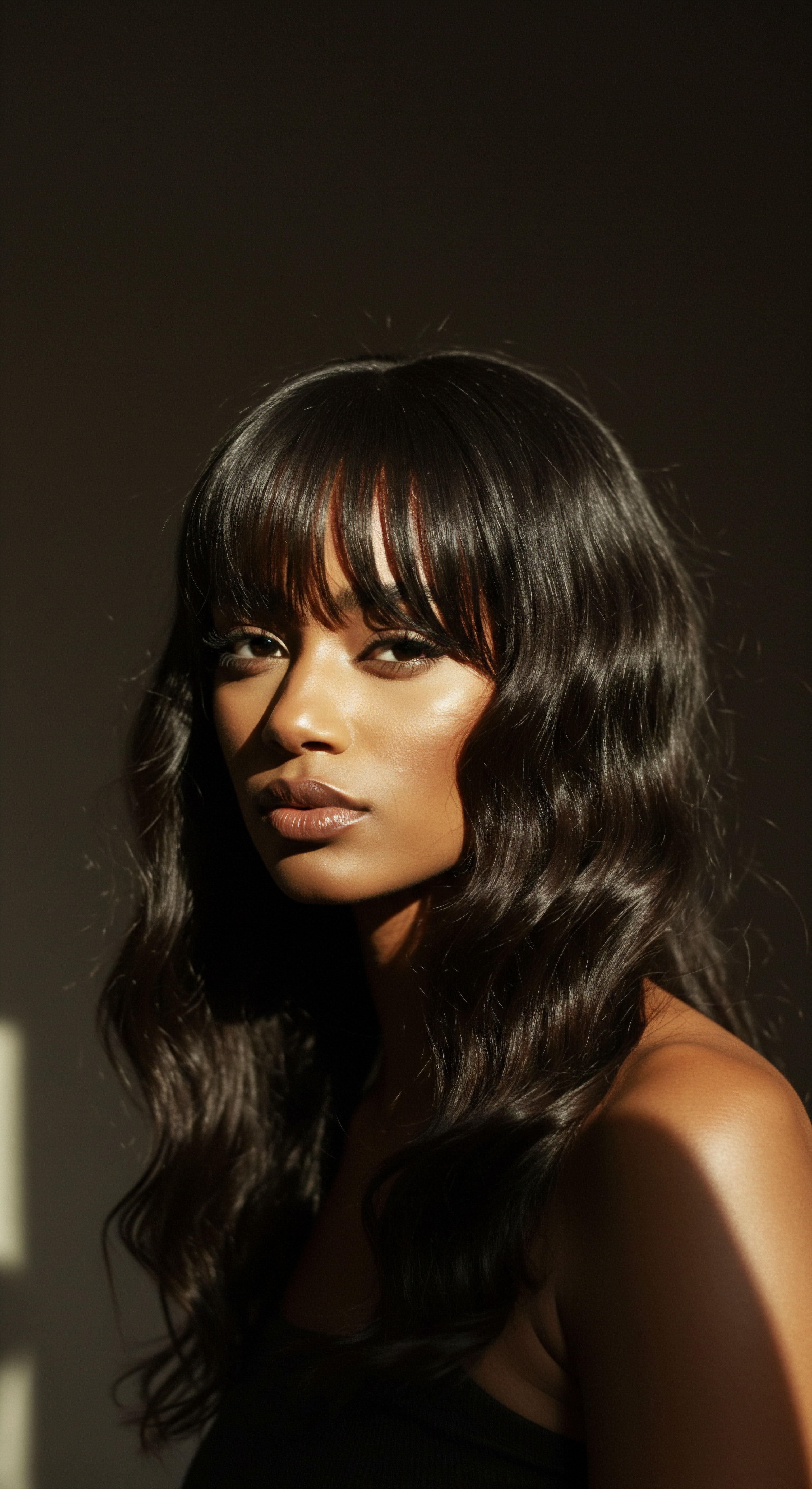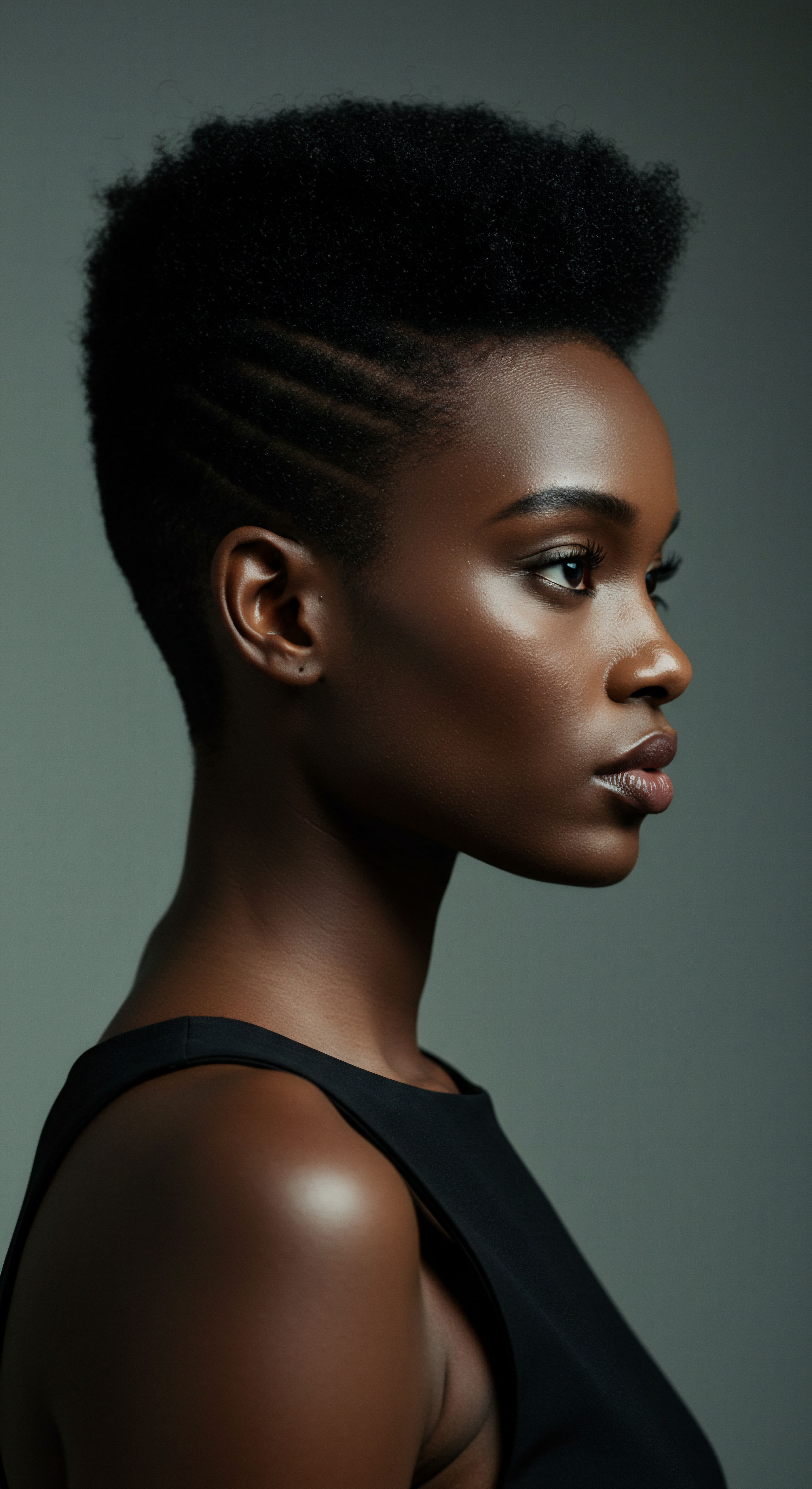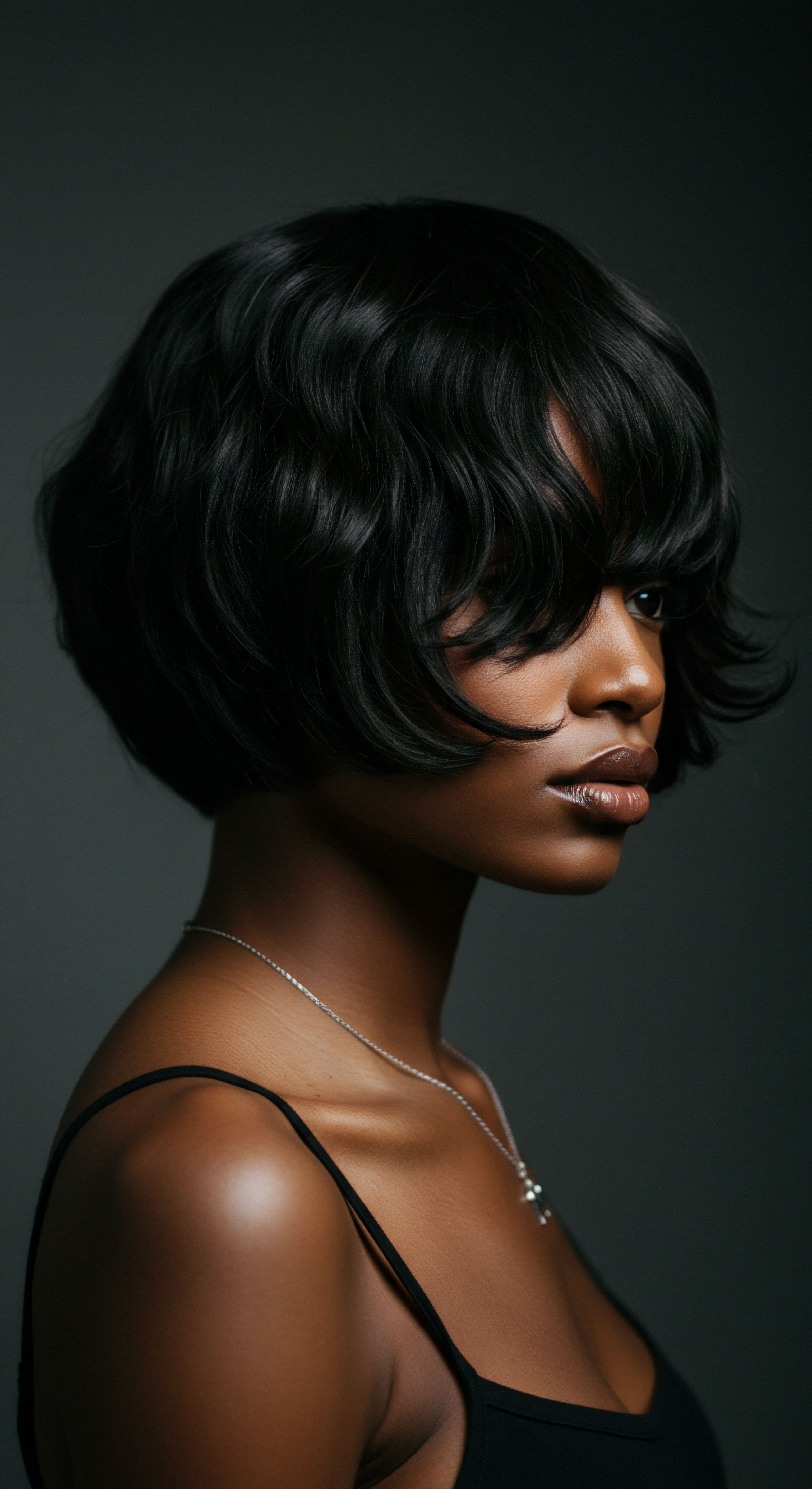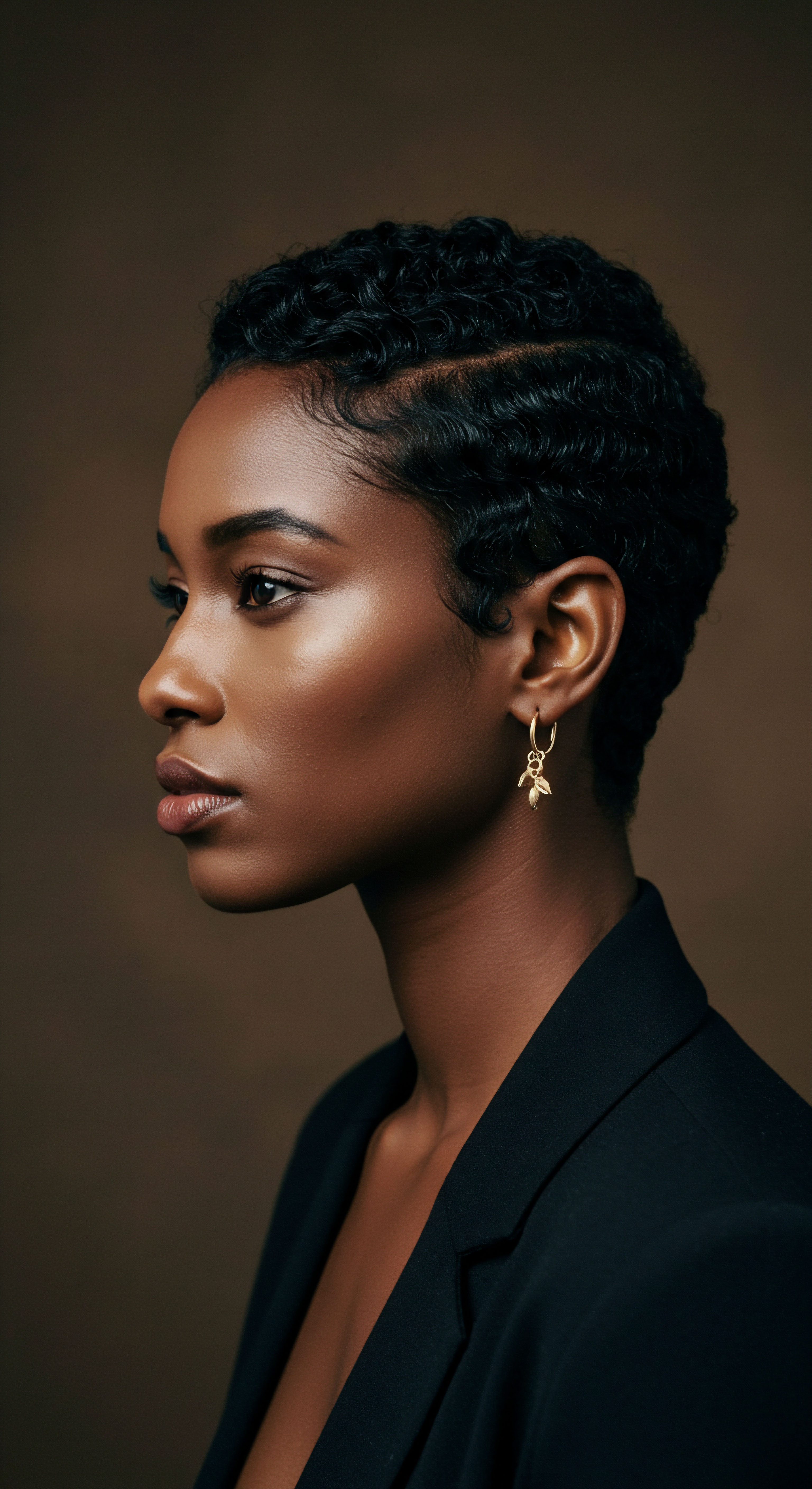
Roots
A whisper from ancient riverbanks, carried through millennia by the desert air, speaks of a deep connection between human identity and the very strands that crown us. The question of what royal mummies’ hair can tell us about its natural texture calls us to listen closely, to perceive the silent declarations of history held within each preserved coil and wave. It is a dialogue between the past and our present understanding of hair, particularly for those of us who cherish the rich variations of textured hair.
This journey into antiquity is not merely an academic pursuit; it is a warm invitation to connect with the timeless artistry and inherent science of human hair, as revealed by those who walked the earth long ago. Their preserved locks offer a window into biological truths and societal practices that continue to shape our perception of beauty and well-being today.

Hair’s Enduring Structure
The incredible survival of hair on royal mummies provides a tangible link to ancient individuals. Hair, composed primarily of a protein called Keratin, possesses a remarkable resilience against decay. This robust protein, built from amino acid chains, maintains its structural integrity over vast spans of time when environmental conditions are favorable, such as the arid climate of Egypt.
Scientific analysis, including advanced microbeam synchrotron techniques, confirms a notable conservation of keratin’s organized packing at both macroscopic and molecular levels in these ancient samples. Even after thousands of years, the cuticle scales, the outermost protective layer of the hair shaft, remain observable, a testament to hair’s inherent durability.
Hair’s enduring protein structure, keratin, allowed it to withstand millennia, providing scientists a unique window into ancient individuals.
While some oxidation of the cuticle and keratin protein may occur, as seen in studies of Nubian mummy hair, the overall physical and chemical properties stay remarkably well-preserved under low humidity and non-alkaline conditions. This allows for detailed examination of hair morphology, revealing details about shaft diameter, cuticle scale patterns, and the presence or absence of a medulla, the innermost core of the hair. These microscopic characteristics offer clues about the hair’s original texture and type, even after centuries of repose.

Uncovering Ancient Hair Types
The examination of royal mummies’ hair, alongside that of other ancient Egyptians, suggests a diverse spectrum of natural hair textures. While depictions in art often present idealized forms, direct analysis of the hair itself tells a more nuanced story. Researchers have observed a range from relatively straight to wavy, and various degrees of curl, including tighter coil patterns. This diversity reflects the natural genetic variations present within the ancient Egyptian population, a mix of ancestries that gave rise to a wide array of hair types.
- Hair Morphology ❉ Studies on mummified hair often look at the cross-sectional shape of the hair shaft. More circular shafts tend to correlate with straighter hair, while oval or flattened shafts indicate wavier or curlier textures.
- Curl Variables ❉ Researchers quantify curl by measuring factors like maximum to minimum curvature, providing a more objective assessment of wave and coil patterns.
- Pigmentation ❉ The natural color of hair is also a key characteristic, determined by melanin. While post-mortem changes can occur, modern analytical methods help distinguish original pigmentation.
A study examining hair samples from burials in Semna South, a Nubian region, provides compelling evidence of this textural variety. This research noted “curling variables intermediate between European and African samples,” with some instances showing “more African elements” in the curling patterns. This finding highlights the presence of hair with tighter curl and coil configurations among ancient populations connected to Egypt. The adoption of the “Nubian wig” by figures like Queen Nefertiti, specifically designed to mimic short, curly hair, further underscores the presence and perhaps admiration of these textures within elite circles.

Did Some Egyptians Have Naturally Fair Hair?
A fascinating and somewhat unexpected revelation from mummy hair analysis concerns natural hair color. For a long time, the prevailing thought was that any lighter hair color observed on mummies, such as blonde or red, was a result of the mummification process itself, particularly the drying agent natron. However, recent scientific inquiry has presented a different perspective.
Dr. Janet Davey from the Victorian Institute of Forensic Medicine in Australia conducted a study to test this very assumption. She and her colleague, Alan Elliot, prepared synthetic natron and applied it to 16 modern hair samples of various colors for 40 days, replicating the mummification period. The results were quite telling ❉ the hair samples showed no significant lightening; some even darkened.
This led Dr. Davey to conclude that the fair hair observed on some ancient Egyptian mummies, particularly three unwrapped children from the Graeco-Roman Period, was not a result of natron exposure or post-mortem changes. Instead, it was likely due to their natural ancestry, pointing to a broader genetic diversity within ancient Egypt than previously thought.
This finding challenges a long-held belief and expands our perception of the physical appearance of ancient Egyptians, adding another layer to the understanding of their natural attributes. Ramesses II, a prominent pharaoh, is another instance where microscopic analysis of his mummy’s hair confirmed he was naturally red-haired in his youth, with henna applied later, possibly to restore a youthful appearance. These instances prompt us to consider the full spectrum of natural hair characteristics present in ancient times, reminding us that human diversity is a timeless constant.

Ritual
Stepping beyond the inherent structure of hair, we turn our attention to the deliberate actions, the daily and ceremonial practices, that shaped its presentation in ancient Egypt. The hair of royal mummies, far from being merely preserved, often bears the marks of meticulous care and sophisticated styling. This tells us a compelling story about how ancient Egyptians approached their hair, not just as a biological attribute, but as a canvas for self-expression, a symbol of status, and a subject of dedicated attention. Their approach, much like our own contemporary hair rituals, was deeply rooted in a desire for appearance, well-being, and cultural connection.

What Styling Products Were Used?
Evidence from mummy hair analysis reveals that ancient Egyptians were adept at creating and using hair styling products. Scientists have identified a fat-based substance coating the hair of many mummies, including those naturally preserved in the desert. This substance, analyzed through gas chromatography-mass spectrometry, contained biological long-chain fatty acids, such as palmitic and stearic acid. Researchers propose this was a kind of ancient “hair gel” or fixative, used in life to hold hairstyles in place.
This fatty substance was applied to both natural hair and wigs, demonstrating a conscious effort to maintain desired styles. The discovery suggests that hair care was so important that the mummification process itself was adapted to preserve these styled appearances, indicating a desire to retain individuality even in death. The use of such products points to an understanding of how to manipulate hair texture and form, providing hold and possibly a lustrous finish.
Ancient Egyptians used a fat-based substance, akin to modern hair gel, to sculpt and maintain hairstyles, even ensuring these styles persisted into the afterlife.
Beyond styling, ancient Egyptians utilized various natural oils for hair health. Castor Oil and Almond Oil were employed in nourishing masks and scalp treatments, aimed at improving moisture retention and elasticity. Pomegranate oil, rich in antioxidants, was also used as a protective shield against environmental damage, suggesting an early awareness of hair’s vulnerability to external factors. These practices highlight a holistic view of hair care, where appearance was linked to underlying health.

How Did They Style Textured Hair?
Ancient Egyptian hairstyles, whether on natural hair or elaborate wigs, showcased remarkable artistry and a practical understanding of different textures. For those with naturally wavy or curly hair, various methods were employed to enhance or control their patterns. Evidence suggests the use of metal implements resembling curling tongs, which might have been used in conjunction with the fat-based styling products to create and set curls.
Wigs were particularly prevalent among the elite and royalty, serving as symbols of status, hygiene, and fashion. These wigs were often crafted from human hair, sometimes combined with plant fibers or wool, and were meticulously styled. They were frequently set with beeswax and resin, which hardened to hold the desired shape, even in the warm Egyptian climate.
- Braiding ❉ Many mummies show their natural hair or wig components styled into numerous fine plaits or twisted tresses. This technique was a common way to manage and adorn hair, particularly longer styles.
- Extensions ❉ Hair extensions were a popular option, used to add volume or length to natural hair, or to hide thinning areas. These were often secured with beeswax and resin.
- Henna Application ❉ Henna, derived from the Lawsonia plant, was widely used to color hair, often to cover gray strands or impart a reddish tint. It also offered conditioning properties. This practice was sometimes applied post-mortem, possibly as part of mourning rituals or to restore a youthful appearance for the afterlife.
The presence of specialized hairdressers, mentioned in ancient texts and depicted in tomb paintings, confirms that hair styling was a skilled profession. Reliefs, such as one on the sarcophagus of Queen Kawit, show hairdressers tending to royal locks, underscoring the importance placed on hair appearance. These historical practices mirror many modern approaches to textured hair, where skilled hands, natural ingredients, and specific techniques combine to celebrate and enhance natural beauty.

Relay
To consider what royal mummies’ hair reveals about its natural texture is to embark on a journey that transcends simple observation, moving into a space where science, cultural practice, and the human desire for self-presentation converge. The preservation of these ancient locks provides not just a static image, but a dynamic dialogue with the past, allowing us to perceive how biological realities intersected with societal values. It is a story of how deeply hair was integrated into identity, not only in life but also in the solemn transition to the afterlife, and how these ancient echoes resonate with our contemporary understanding of textured hair.

The Deeper Meaning of Hair in Antiquity
Hair in ancient Egypt held a profound significance that extended far beyond mere aesthetics. It acted as a powerful symbol of gender, age, social standing, and even religious connection. The elaborate hairstyles and wigs seen on royal mummies and in artistic representations were not simply fashionable; they were deliberate statements within a structured society. For instance, elite men often wore elaborate wigs above shoulder level, with the most distinguished styles arranged in intricate strands, curls, or braids, visually signaling their elevated status.
The decision to shave one’s head, or to wear a wig, was often tied to hygiene, status, and ritual purity. Priests, for example, frequently shaved their heads to prevent lice and maintain ritual cleanliness, a practice noted by ancient Greek historians. Children universally had shaven heads, often with a single “sidelock of youth,” a symbolic plait linked to the god Horus and signifying protection. This intricate system of hair presentation underscores its central role in defining identity and place within the ancient Egyptian world.

What Do Modern Analyses Tell Us About Ancient Hair Health?
Modern scientific analysis of mummy hair extends beyond mere visual inspection, providing surprising insights into the health and condition of these ancient strands. Techniques like gas chromatography-mass spectrometry (GC-MS) and microbeam synchrotron imaging allow researchers to investigate the molecular composition and structural integrity of hair, even after millennia.
One compelling finding concerns the widespread use of a fat-based hair dressing. A study published in the Journal of Archaeological Science in 2011, led by Dr. Natalie McCreesh, examined hair samples from 18 mummies. It revealed that nine of these mummies had hair coated in a substance containing long-chain fatty acids.
This application was so integral that embalming procedures were adjusted to preserve hairstyles, ensuring the deceased’s individuality persisted beyond life. This discovery suggests that ancient Egyptians understood how to maintain hair’s appearance and potentially its suppleness, much like modern conditioners and styling creams aim to do. The fact that different materials were sometimes used for hair compared to the rest of the body speaks to a specialized approach to hair preservation within the mummification process itself.
Another study, focusing on the keratin structure of mummy hair using synchrotron techniques, observed a remarkable conservation of the molecular and supramolecular structure of fibrillar keratins. This means that despite the passage of time, the fundamental building blocks of the hair fiber remained largely intact, offering valuable data on the resilience of human hair and the effectiveness of ancient preservation methods.
Consider the case of ancient Egyptian hair color. While most unwrapped mummified bodies show dark brown or black hair, instances of fair hair have sometimes been attributed to post-mortem changes caused by natron, the salt used in mummification. However, research by Janet Davey and Alan Elliot, published in 2020, challenged this long-held assumption. Their experimental replication of natron exposure on modern hair samples demonstrated no significant lightening; indeed, some samples darkened.
This suggests that the occasional fair hair observed on mummies, particularly among children from the Graeco-Roman Period, was likely their natural hair color, indicating a greater genetic diversity in ancient Egypt than often assumed. This finding is significant because it shifts our understanding from an environmental alteration to a biological reality, painting a more complete picture of the physical characteristics of ancient Egyptians.
| Aspect of Hair Hair Structure |
| Scientific Finding Keratin's molecular organization remarkably preserved. |
| Implication Hair is highly durable, offering reliable long-term biological data. |
| Aspect of Hair Styling Products |
| Scientific Finding Fat-based 'gel' (fatty acids like palmitic, stearic) identified. |
| Implication Ancient Egyptians used sophisticated fixatives for hair styling. |
| Aspect of Hair Hair Color |
| Scientific Finding Some fair hair is natural, not due to mummification chemicals. |
| Implication Greater genetic diversity in ancient Egyptian populations. |
| Aspect of Hair Hair Health |
| Scientific Finding Evidence of natural oils (castor, almond, pomegranate) use. |
| Implication Early understanding of hair nourishment and protection. |
| Aspect of Hair These findings collectively illustrate the advanced understanding and care for hair in ancient Egyptian society. |

How Do Ancient Hair Practices Inform Modern Textured Hair Care?
The echoes of ancient Egyptian hair practices reverberate into contemporary textured hair care, offering lessons that are surprisingly relevant. The meticulous attention to hair health and appearance, the use of natural oils, and the ingenuity in styling products speak to universal principles of hair care that transcend time.
The ancient use of fat-based products for styling and conditioning aligns with modern approaches that rely on rich butters and oils to moisturize and define textured strands. Shea butter, for instance, a staple in many modern textured hair routines, is rich in stearic acid, one of the fatty acids found in ancient Egyptian hair treatments. This parallel suggests a long-standing understanding of what makes textured hair thrive ❉ adequate moisture and pliable hold.
The emphasis on protective styling, seen in the prevalence of braids and wigs, also finds a mirror in today’s textured hair community. Protective styles safeguard delicate strands from environmental stressors and manipulation, a concept understood millennia ago. The use of henna for both color and conditioning also remains a popular natural option today, celebrated for its chemical-free properties and ability to strengthen hair.
These historical practices remind us that the quest for healthy, beautiful hair is a timeless pursuit, deeply rooted in human culture. They invite us to view our own routines not as isolated modern phenomena, but as part of a continuous legacy of care and celebration for the unique qualities of textured hair.

Reflection
To gaze upon the preserved hair of royal mummies is to glimpse more than just ancient styles; it is to perceive a profound connection to human identity and the enduring significance of our strands. These ancient relics speak not only of natural texture, revealing waves, curls, and perhaps even unexpected hues, but also of a society that understood hair as a canvas for expression, a marker of status, and a recipient of dedicated care. The silent testimony of these millennia-old locks reminds us that the quest for hair well-being, for adornment that reflects who we are, is a timeless human endeavor, linking our present textured hair journeys to the deep currents of history.

References
- Blais, Summer. Beyond Beautiful ❉ Ancient Egyptian Cosmetics. CommonLit.
- Fletcher, Joann. Ancient Egyptian Hair ❉ a study in style, form and function. Unpublished PhD thesis, University of Manchester. 1995.
- Fletcher, Joann. The Most Democratic Form of Adornment Through their hairstyles and wigs, still visible in art and preserved on mummies, much can be gleaned about the ancient Egyptians’ fashion, health, diet and lifestyle across time. Rawi.
- Fletcher, J. and Salamone, F. An Ancient Egyptian Wig ❉ Construction and Reconstruction. Internet Archaeology 42. 2016.
- Hrdy, D. B. Analysis of hair samples of mummies from Semma South (Sudanese Nubia). Am J Phys Anthropol. 1978 Aug;49(2):277-82.
- Kandil, Hoda Abd Allah, and Salama, Mahmoud El-Mohamdy Abdelhady. Role of the Hair in Ancient Egypt. International Journal of Tourism and Hospitality Management Volume 1, No. 1. 2018.
- Manniche, Lise. Sacred Luxuries ❉ Fragrance, Aromatherapy, and Cosmetics in Ancient Egypt. Cornell University Press. 1999.
- McCreesh, N. C. Gize, A. P. and David, A. R. Ancient Egyptian Hair Gel ❉ New Insight into Ancient Egyptian Mummification Procedures through Chemical Analysis. Journal of Archaeological Science 38, no. 12. 2011.
- McCreesh, N. C. and Gize, A. P. Is ancestry, not natron, an explanation for fair haired children in Greco-Roman Egypt? Forensic Science International ❉ Reports. 2020.
- Robins, Gay. Hair, Gender, and Social Status in Ancient Egypt. JSTOR Daily. 2020.